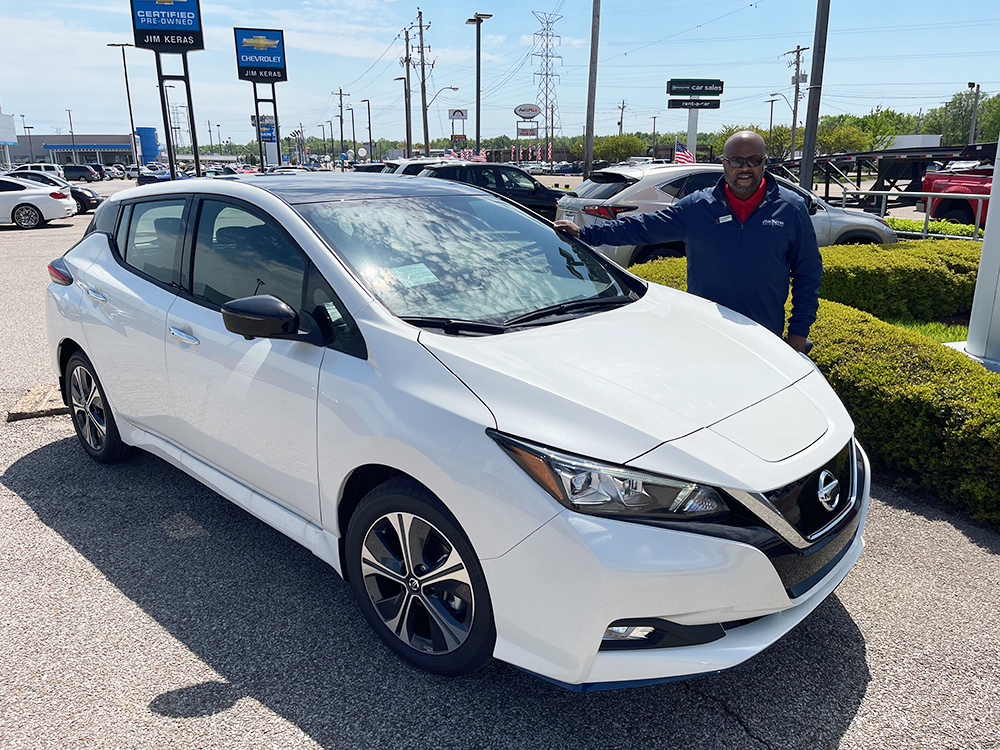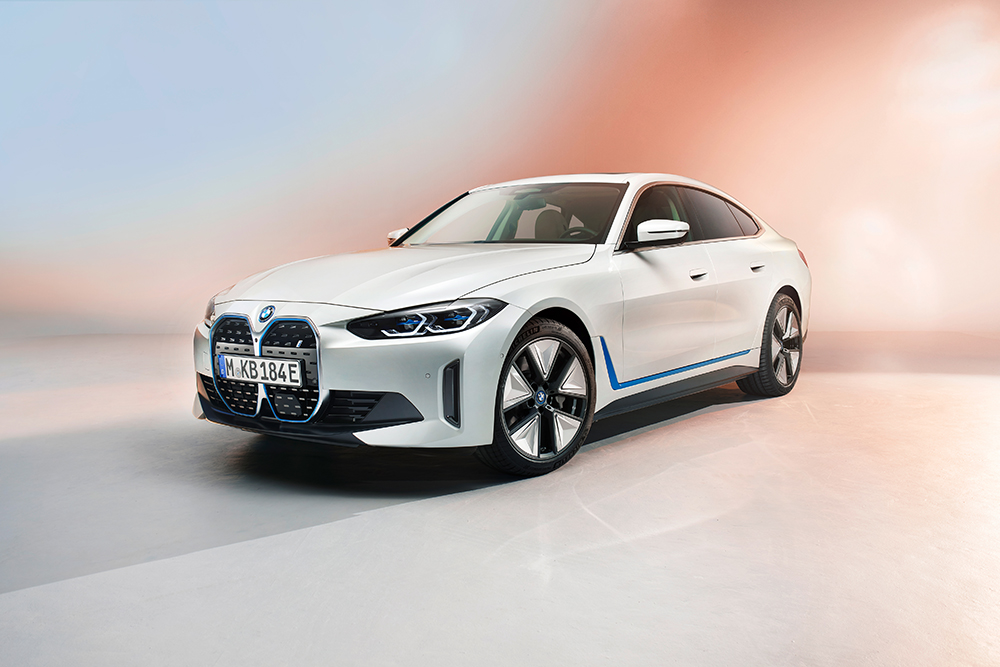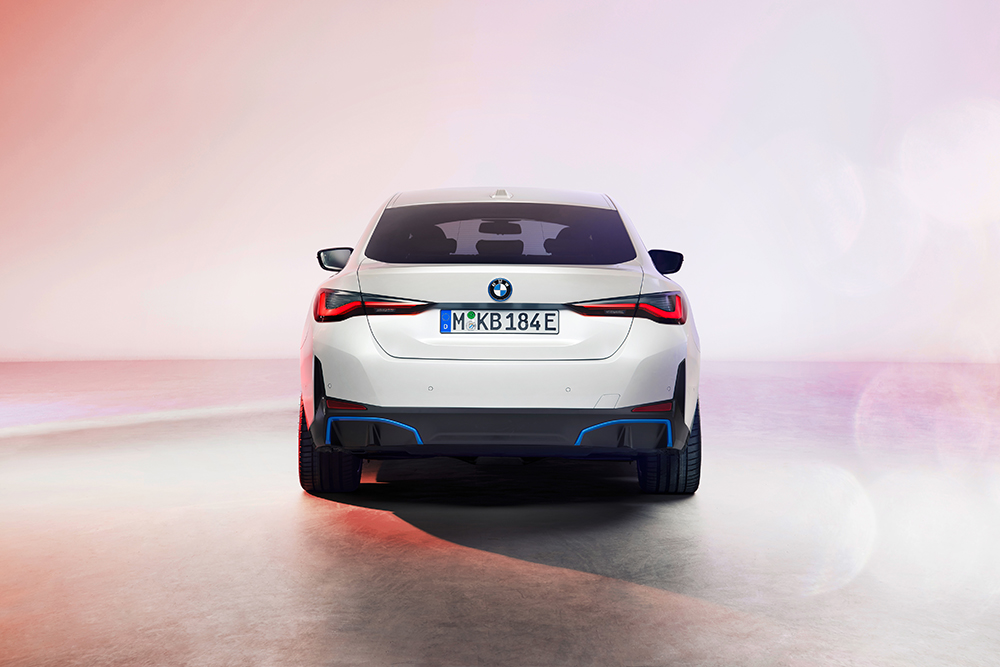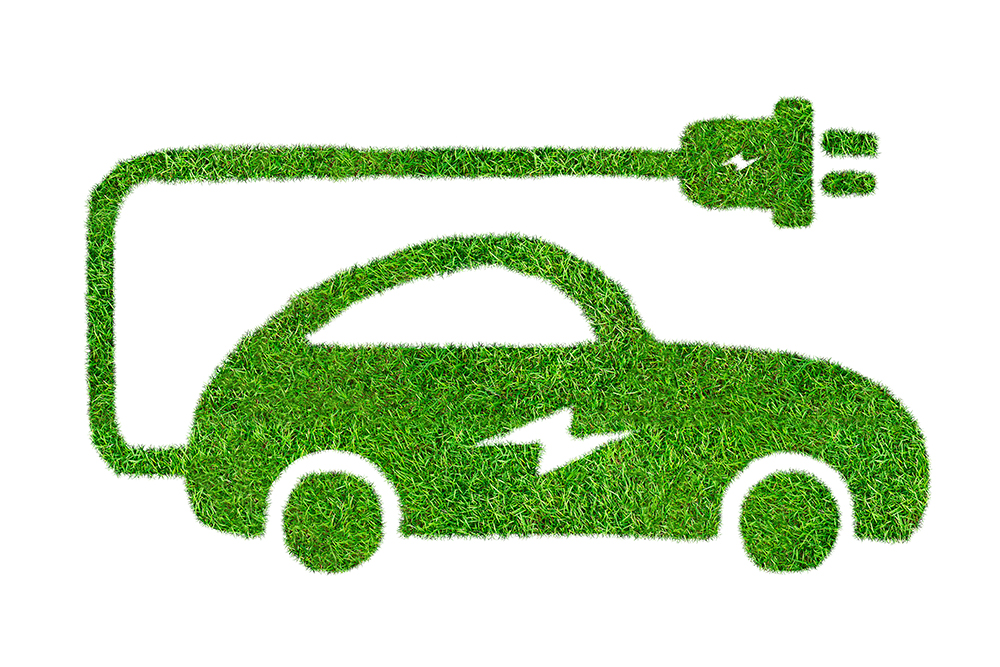When the light turns green, the work truck ahead of me belches out a cloud of dark smoke. I drive through the black cloud, and after a second, the smell seeps in. It’s that familiar stench of half-burned hydrocarbons that permeates so much of modern life.
I’m behind the wheel of a 2021 Nissan Leaf, which, unlike the lumbering work truck in front of me, has no tailpipe to emit smoke, water vapor, or, worst of all, carbon dioxide. It’s an electric vehicle (EV) which runs on energy stored in the 62-kilowatt lithium ion battery beneath my feet. Introduced in 2011, and built in Smyrna, Tennessee, the Leaf was the world’s best-selling EV for nine years, until it was surpassed by the Tesla Model 3 in 2020. “We were one of the first ones on the market,” says Maurice Walker, internet director for Jim Keras Nissan.
Today, there are more than 1.7 million electric cars on the road in the United States. “There are about 13,000 across the state of Tennessee,” says Becky Williamson, strategic marketing coordinator for MLGW. “Most of those are congregated in the large metro areas of Nashville, Memphis, Knoxville, and Chattanooga.”

(Photo: Chris McCoy)
Walker, who has been selling the Leaf since its 2011 debut, says concern about climate change is the biggest reason people buy EVs. “For all of the customers we’ve sold to, their main idea was to help the environment, to cut down on emissions, as well as save some money by not having to go to the gas pump. It worked out really well for them. [The Leaf] had a very aggressive lease to get them out there, so you’re looking at payments between $200 and $300 a month for a $40,000 vehicle that could get you to and from in comfort, and you don’t have to stop at the gas station. So it was way cheaper than driving anything else in the market.”
According to Drive Electric Tennessee, fuel costs for a traditional gasoline-powered internal combustion engine run between $0.12 to $0.13 per mile, while it only takes $0.02-$0.04 per mile to charge an EV. But EV sales represent only about 2 percent of the American automotive market, which is dominated by SUVs and big trucks, like the Ford F-150. Walker says even though the Leaf is manufactured here in Tennessee, most of Nissan’s sales are in states with strict emissions controls, like California. “You can’t even sell a [Nissan] Armada [SUV] in California, because it doesn’t pass the emissions test,” he says.
Tennessee has much looser emissions standards. “In Memphis, it doesn’t sell as well,” says Walker. There’s one overwhelming reason for that sales gap: “range anxiety.”
Energy Density
It takes a lot of power to move you and your metal chariot down the road to grandma’s house, so you need a means of carrying energy with you. Throughout the 1800s, would-be automotive engineers came up with a lot of different storage methods, from coal-fed steam power, like a locomotive, to compressed air. Electricity, stored in lead acid batteries, was tried very early. The American inventor Robert Anderson had a working electric car in 1832; by the turn of the century, a fleet of electric taxis roamed New York City. A full third of all automobiles sold between 1900 and 1912 were electric.
That would soon change. The internal combustion engine, invented by Karl Benz in 1886, ran on a potent liquid fuel derived from crude oil. Gasoline is one of the most energy-dense substances known. In physics terms, it contains 34 megajoules of energy per liter of volume. For comparison, a modern lithium ion battery, like the one in the Nissan Leaf, can hold about two megajoules per liter. That means, all things being equal, you can get a lot farther with one liter of gasoline than one liter of lithium. In the 1920s, when Ford introduced the gas-powered Model T, the crude batteries of the day couldn’t compete either in range or price. Electric cars disappeared from the road.
But the EV’s saving grace is that all things are not equal. The internal combustion engine is extremely inefficient. About 65 percent of the energy stored in gasoline is wasted when it’s burned in an engine, mostly to the vast amounts of waste heat that must be dissipated by a car’s radiator. Electric motors waste only about 10 percent of the energy stored in the battery. Electric cars are much lighter and have fewer moving parts. That means no oil changes, and much less maintenance. “Rotate the tires every 10,000 miles, and get the battery checked once every 12 months,” says Walker. “I think the total service for all of that is about $200 a year, which is way cheaper than anything else.”
Three years ago, Shannon Dixon bought a used 2015 Nissan Leaf. “What I like about it is, it’s really fast. It has no lag. You hit the pedal, and you’re out of there, so you can get out of some tricky traffic situations. It just feels very nimble. I love the environmental benefits of it, for sure, and the economic benefits. It has not been to the shop yet.”
The listed range of the 24 kWh battery pack is 84 miles, “… but it really has to be perfect temperature,” says Dixon. “If it’s too cold, the battery works really hard to recharge. The same if it’s really hot.”
Heating and air conditioning can also cut into the range, and as the battery pack ages, it holds less energy. But Dixon says range is rarely a problem. The average American drove about 26 miles per day in 2017, so even a battery pack that is six years into its estimated 10-year lifespan is more than adequate for most days. “You have to learn the car, and you have to learn a few tricks on how to increase your range,” she says.
Over the last two decades, EV manufacturers have pursued a lot of strategies to extend range. One of those is regenerative braking, which was pioneered by gas-electric hybrid vehicles like the Toyota Prius. When Dixon wants to slow down in her Leaf, the electric motors switch from drawing power from the batteries to harvesting power from the car’s momentum to feed back to the batteries. Most EVs come with the option of “one-pedal driving,” where regenerative braking kicks in automatically, and the brakes are only for emergencies. “If you don’t have your foot on the — I was going to say the gas pedal, but it’s the electric pedal — in the battery mode, it slows down, and really saves you the miles,” Dixon says. “That’s kind of fun. I like to try to game it sometimes: Can I drive from here to there without losing any electric miles?”
In my test drive of the 2021 Nissan Leaf, I switch to one-pedal mode at a stoplight. It’s like driving a golf cart, and a little disorienting at first. I stop next to the Malco Summer Drive-In to do some math. Over the last decade, battery technology has grown by leaps and bounds. According to my dashboard meter, the battery is at 94 percent, which will take me 205 miles. I could make it to Nashville, Little Rock, or Jackson, Mississippi, before needing a recharge. I hop on I-240 to return to Covington Pike, accelerating onto the freeway like normal. By the time I look at the speedometer, I’ve topped 90 mph.
Charge Up
“This is the gem of your story,” says MLGW’s Williamson. “All you need to do is go pick up your electric vehicle from the dealer, drive it home, and plug it into the outlet that is more than likely already sitting there in your garage or carport. You can charge an electric vehicle with a standard, 120-volt outlet.”
Most EV owners “trickle charge” their vehicles overnight and wake up with more than enough juice in the batteries to get where they need to go. You can also opt for a Level 2 charger, which requires the installation of a dedicated, 240-volt circuit. “Those are the types of chargers that typically you find at businesses,” says Williamson. “The ones at Shelby Farms, which were installed in the last decade as a part of our EV project, are Level 2 chargers.”
A Level 2 charger can fully charge a battery in five hours, adding 12-60 miles of range per hour. “In most public places, people are just charging for the 30 minutes they’re in the grocery store, or the couple of hours they’re having dinner.”
Newer Level 3 chargers, also known as DC Fast Chargers, can get a depleted EV back on the road with an 80 percent charge in about a half hour. Networks of Level 3 chargers, like Tesla Superchargers, are springing up all over the country, according to Williamson. “There are about 12 to 15 of those DC fast-charging stations here in Shelby County.”
Range anxiety is really infrastructure anxiety — gas stations are everywhere, but will there be a charger handy when I need it? With the help of websites such as PlugShare, which keeps track of every publicly available charger, it’s increasingly possible and convenient to string together longer journeys.
But Karen Lombardo, general manager of Roadshow BMW Mini, is not sure it’s enough to overcome EV reluctance for many drivers. “They want to be able to just jump in the truck, drive down to Destin, and not have to worry about it,” she says. “Not necessarily speaking from my professional opinion, but more my personal opinion, I think one of the reasons that people have wanted to wait on electric is that they don’t just look at their car as a commuter vehicle. The United States is different from other parts of the world, where people don’t take their personal commuter on trips. They jump on a train in Europe, or they can fly from country to country very easily and affordably. Here, people look at their vehicle as their freedom — especially in the last 12 months, with COVID making people not want to fly.”
BMW was another early entrant into the EV game. The i3, an advanced compact hatchback made with lightweight, carbon fiber components, debuted in 2014 with an 83-mile range — the top 2021 model will go 180 miles. The i3’s technology and unique styling earned three World Car of the Year awards, but less than 42,000 have sold in America. Still, Lombardo says BMW considers the i3 experiment a success. “The expectation wasn’t there that the i3 was going to sell the way the 3-Series does.”
Companies like BMW, who have spent the last century building up an infrastructure to support fossil fuel-powered cars, use projects like the i3 to gauge what will be needed to support the new technology. “We have to make sure that we can provide the same service level to the electric vehicle owner as we can to the rest of our client base.”


These lessons are being applied to the BMW i4, which will make its debut in 2022. It’s a more conventionally styled sedan, which sports the distinctive BMW kidney grill. The i4 will have a 300-mile range, handle like a sports car, and go zero to 60 in four seconds.
A similar pattern is playing out across the industry. After a decade of development, Nissan Leaf sales are up 50 percent in 2021; in 2022, the company will introduce the Ariya, an electric SUV with a 300-mile range. The new Ford Mustang Mach-E will deliver similar performance for around $40,000. GM is rebooting the infamously thirsty Hummer as a 300-mile EV supertruck and expects to offer only electric vehicles by 2035. Audi, Volkswagen, and Porsche have also pledged to go all-electric in the next 20 years.
Williamson says MLGW has seen interest in electric cars wax and wane over the years, but this time is different. “Drive Electric Tennessee is looking for 200,000 EVs across the state of Tennessee by 2028,” she says. MLGW expects to see 50,000 EVs on its grid in the next 20 years, “… and that’s not taking into account buses and other unique electric vehicles.”
Lombardo agrees there has been renewed interest in EVs. “I would say the last 12 months, in Memphis, Tennessee, I’ve seen Tesla registrations increase by a lot.”
The Future
Founded in 2003 by engineers Martin Eberhard and Marc Tarpenning, Tesla has been associated with Elon Musk since he took over as CEO in 2008. The vehicles have a reputation as the most advanced EVs on the market; there are more than 800,000 Model 3s on the road.
Adam Hohenberg says when he needed a new car, he intended to buy a Chevy Volt plug-in hybrid — only to find Chevrolet had discontinued it. “When I looked around, it just seemed like Tesla was really far ahead of everybody else, and it wasn’t that much more than a hybrid.”
Hohenberg says he has had no regrets. “It’s been great. It just plugs in, and you go. In my garage, I get 45 miles of range per hour. You don’t even charge it all the way up unless you’re going on the highway. I’ve taken it on the road to Florida and to Hot Springs, and you just stop at Superchargers. They’re all just off the highway, so I just stop for 20 minutes a couple of times, and that’s it.”
Investors think EVs are the future: Tesla’s market capitalization is currently $820 billion. That, more than anything, explains why old line automotive companies are rushing EVs into production, and why wave after wave of EV startups have flooded the capital markets.
One of those startups is Mullen Technologies, which recently announced plans to open a manufacturing facility to produce a Chinese-designed electric SUV in a former Nike warehouse at 8400 Winchester Road in Memphis. The project was granted a 15-year Jobs PILOT by the Economic Development Growth Engine for Memphis and Shelby County (EDGE). “We were attracted by the fact that they have an exceptional leadership team,” says Reid Dulberger, president and CEO of EDGE. “They have what appears to be a very sound vision and a path forward. Nonetheless, it is a hyper-competitive industry. There are many new players trying to get into the market, and you have the established auto companies also pivoting heavily toward electric vehicles. So the total cost of entry into the market is measured in the hundreds of millions of dollars.”
The deal is expected to bring in more than $360 million in new investment and create 434 new jobs with an average wage of $53,000 — if it happens. Mullen Technologies has been in business since 2012, but has never actually produced anything. Repeated requests to the company for interviews were not returned. Dulberger is quick to point out that the PILOT is conditional on Mullen signing the lease, and making the investment.
One thing is clear: The automotive industry is at a moment of great change. “It’s the wave of the future,” says Hohenberg. “You’ll enjoy not smelling fumes or hearing a loud engine. When I got the car, I started noticing all these machines around me, driving around with smoky engines that seemed like they were from another century — which they are.”
